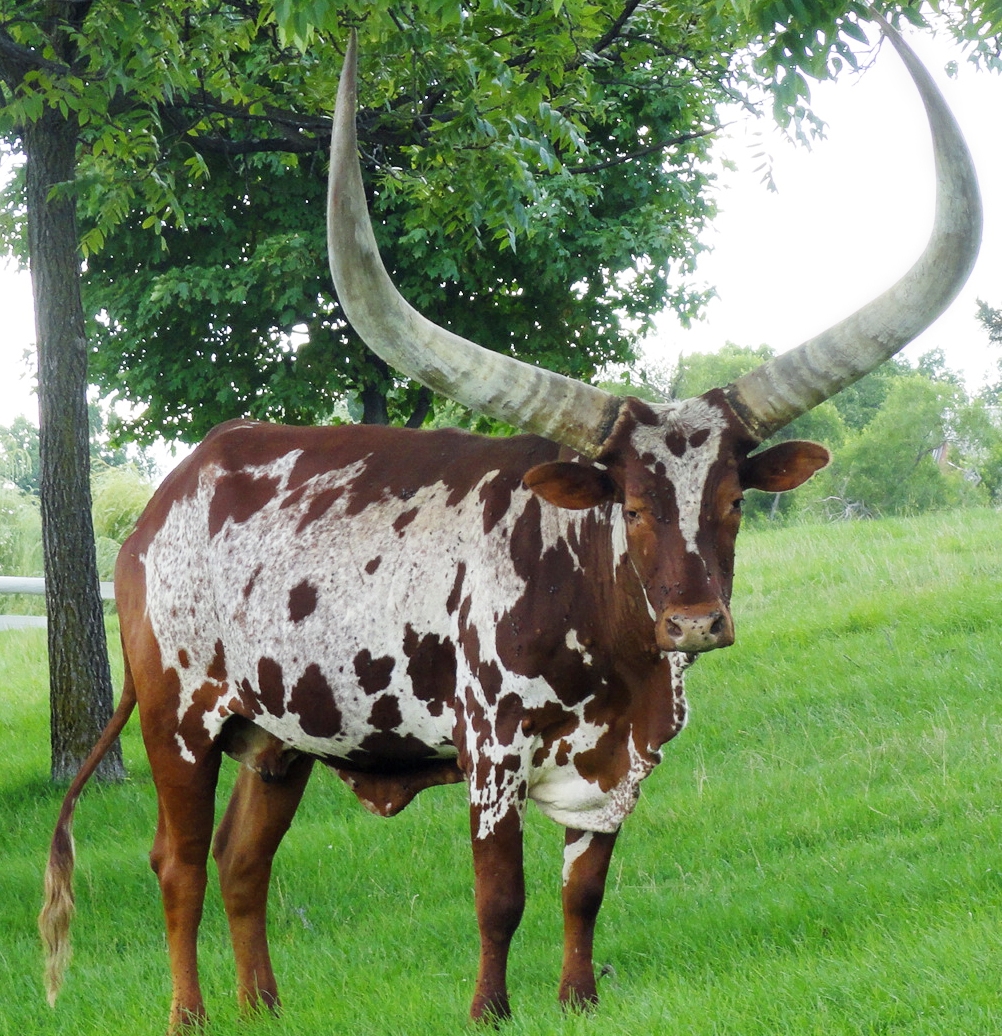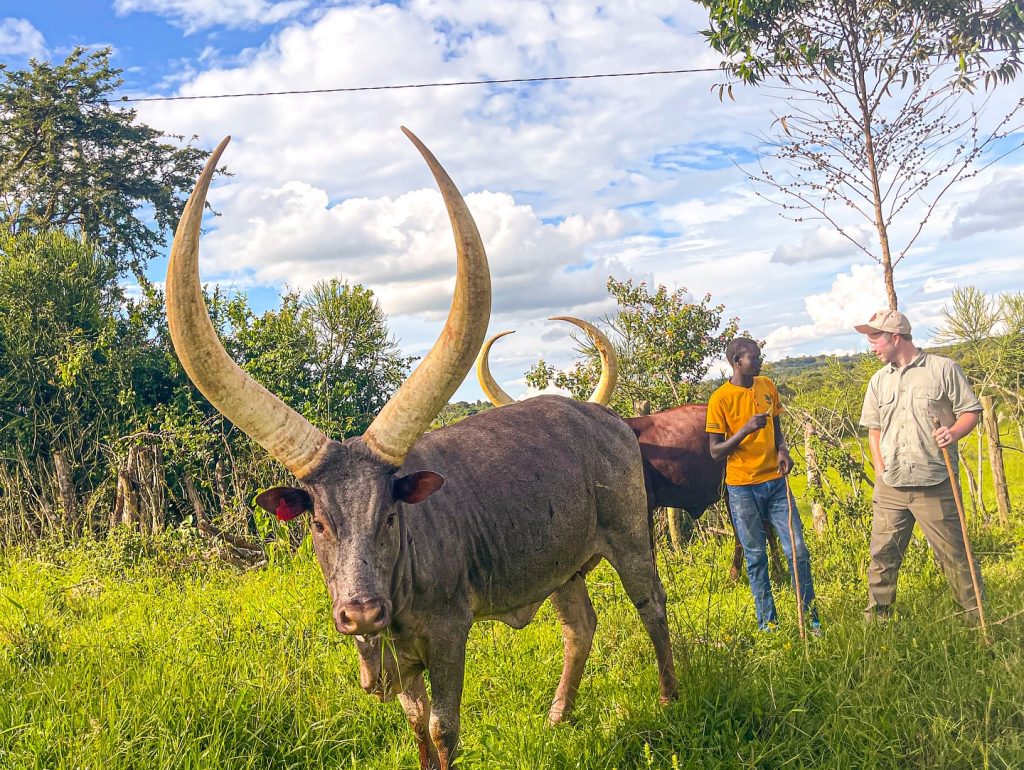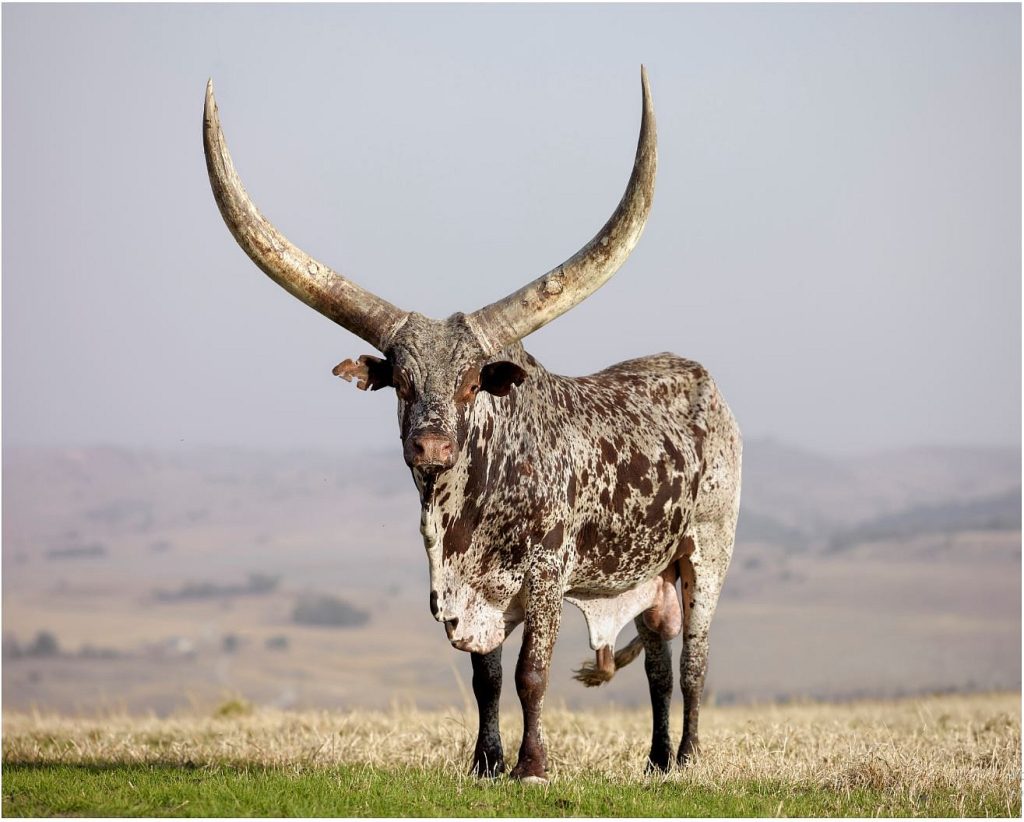Ankole Cattle | Uganda’s Living Icons of Quiet Luxury
Take the early morning road from Kampala toward Mbarara, when the hills are still wrapped in mist and the roadside chapatti stalls haven’t yet fired their first pans. On your way to Bwindi, Queen Elizabeth or Magahinga, just before Mbarara somewhere near Lyantonde, you will definitely see them.
A herd of Ankole cattle, grazing quietly by the roadside, with horns stretching like royal spears into the sky, catching the dawn like polished ivory.
Should they be crossing the roads, even the trucks will slow down—not because they have to, but because they want to. Because this isn’t just cattle. This is Uganda’s heartbeat and for many people, they are impressive to look at.
To the untrained eye, they are beautiful animals. But to a Ugandan—especially a Munyankole—they are much more than just domestic animals. They are pride. They are lineage. They are memory.
These cows are living museums walking across our soil, whispering stories of kings and kraals with every step. If you are seeking a deeper, more luxurious encounter with Uganda, Ankole cattle are not just a photo moment. They are an entry into a world of refined tradition, quiet grace, and elegant simplicity that takes you far from ordinary safaris and into the soul of the land.

Ankole Long Horned Cattle
Ankole Cattle Significance
Ankole cattle are not a product of hurried farming or some sort of genetic shortcuts. These are cows that have evolved over time. Part of the ancient Sanga group, they blend the best of indigenous African stock with the strength of zebu—yet remain distinctly our own. Their most famous feature, of course, are those magnificent horns.
Some stretch over three metres across, rising effortlessly as though sculpted by hand. But despite their size, they’re hollow—light, graceful, and beautifully adapted to channel heat away from the animal’s body.
Their hides? A palette of the land itself. You’ll find deep oxblood browns like the muddy banks of River Rwizi, warm chestnut like Karamoja dust, and creamy whites like clouds rolling over Lake Bunyonyi. No two cows are ever the same, and every herd is a slow-moving canvas of natural elegance.
For guests spending nights in one of the region’s luxury lodges—perhaps sipping tea on a veranda overlooking the Nyabushozi plains—watching a herd pass by is like watching time breathe. Slow. Measured. Majestic.
The Ankole Cattle History
This breed’s story is old—older than Uganda’s colonial lines and longer than the Nile tributaries. They came south with pastoralist tribes, following the grass, guided by stars and ancestral dreams. When the Ankole Kingdom was formed, these cattle took centre stage. They weren’t just wealth—they were royalty. The Enyambo herds, belonging to the Omugabe (king), were treated like sacred beings. Herders polished their horns with banana leaves, called them by name, and sang to them as though they were children.
Even now, many Bahima families in southwestern Uganda still treat their cattle with that same reference. You’ll hear elders speak of cows with tears in their eyes—stories of legendary bulls, miracle calves, and cows that “knew how to listen.” In an age where many things change, these herds remind us that not all value comes with a price tag.
Some families today choose not to sell their purebred Ankoles at all—not for meat, not even for milk production. They keep them for lineage. For identity. For the simple, sacred act of remembering who they are.
Suggested Safari Itineraries
Design Details Worth Noting
Natural climate control: Those elegant horns aren’t just for show. Inside, blood vessels swirl through their hollow cores, dissipating heat and allowing these cows to stay cool during Uganda’s hottest afternoons. While European breeds wilt in the heat, Ankoles stroll through open plains like models on a runway.
Understated endurance: They can walk for kilometres in search of water. They graze on dry grass that most other cows would turn their noses at. Parasites don’t bother them much, and diseases that cripple foreign breeds barely make them flinch. It’s the kind of resilience that doesn’t brag—but commands respect.
Elegant temperament: Soft-spoken herders will tell you: “These cows understand.” And it’s true. Speak kindly, move slowly, and they will look you in the eye—not with fear, but with a quiet dignity. It’s this calm presence that makes spending time among them feel like a silent retreat.

A tourist in the Farm to see Ankole Cattle
Where to See the Ankole Cattle
Mbarara: Known as “the land of milk and honey,” this vibrant town is more than a stopover. It’s a gateway. Private ranches outside town offer immersive kraal visits at dawn—where you can milk a cow using the traditional three-legged ekitara stool, then sip fresh milk from a carved wooden cup under the morning sun. End the day in a hilltop villa overlooking the rolling green sea of cow trails.
Lake Mburo National Park: It’s not just about the zebras here. In the open savannah, you’ll see Ankole cattle grazing freely among impalas and warthogs. The park remains one of the few protected spaces where pastoralism is practiced alongside wildlife conservation. On a luxury game drive, your picnic might include a freshly packed eshabwe tasting with millet bread, under an acacia tree.
Nyabushozi & Kiruhura: With vast grasslands stretch beyond the horizon, dotted with slow-moving herds, this is yet another exciting place to witness the giant-horned Ankole cattle. Helicopter landings are possible here for those who prefer the aerial view, but the real magic is on foot, walking beside a herdsman and hearing tales passed down through generations.
Igongo Cultural Centre: Just outside Mbarara, this museum is more than a tourist stop—it’s a window into Banyankole heritage. Inside, you’ll find ceremonial gourds, royal cow horns, traditional dress, and, if you time it right, a food experience that rivals anything in Kampala. Think pan-fried Ankole beef with smoked eshabwe drizzle and matoke with a touch of ghee.
Signature Experiences, Curated for You
Private Milk-Tasting Ceremony: Step into a kraal at sunrise. An elder stirs a pot of warm, herbed milk. He passes you a cup—not porcelain, but smooth, hand-carved wood. The taste? Earthy, thick, comforting. No sugar needed. Just stories and the soft rhythm of cowbells in the background.
Horn-Polishing Workshop: Sit beside artisans in Kiruhura who turn discarded horns into combs, buttons, and elegant bracelets. Watch them sand and shape the horn until it glows like glass. Then, take home a custom piece—a luxury item with soul.
Sunset Horn Silhouettes: As the sun dips behind the Rwenzori range, stand still. Watch the cows return home, their horns catching the gold light like royal crowns. It’s a view that lingers long after your safari ends.
Ankole-Pairing Degustation: At select lodges, chefs now offer five-course dinners celebrating Ankole produce. Think tender beef carpaccio, rib-eye with matoke honey glaze, and a surprise final course—petit fours with a hint of eshabwe. A marriage of heritage and innovation.
A Breed Under Pressure—and How Luxury Can Help
The truth isn’t easy: pure Ankole cattle are under threat. Foreign breeds give more milk. Land is shrinking. Some youth no longer see the kraal as a future. But this is where conscious luxury comes in. Every traveller who chooses an Ankole experience supports the people who still believe.
Prestigious lodges pay fair prices for Ankole milk and beef. They fund veterinary programs, hire local youth, and honour the storytelling traditions that surround each herd. When you book a stay, sip that milk, listen to that elder—you’re doing more than touring. You’re investing in cultural continuity.
Suggested Safari Itineraries
$ 3495
per person
Subtle Curiosities to Share Over Sundowners
- A young bull’s horn can grow over 1 cm per month—yet still feel as light as a soda bottle.
- The 10,000 UGX note once featured a proud Ankole bull, reminding every Ugandan that beauty and value often come with hooves.
- Cows are sung to in Runyankole. The song is called okuhubira, and it calms both cow and herder alike.
- In drought years, elders believe one special “priest cow” behaves differently—and may signal when it’s time to pray for rain.
Uganda Ankole Cattle FAQs
How close can I safely get?
Very close—if you follow the lead of a seasoned herdsman. A soft “mpola, mpola” tells the cow you mean no harm. Touch the neck first, not the horns.
Is Ankole milk really different?
Absolutely. Thick and full of flavour, it’s the base of eshabwe—a creamy ghee unique to southwestern Uganda. It’s not just milk. It’s identity.
Will I taste Ankole beef?
Yes, but only at high-end ranches with ethical standards. The meat is lean, tender, and has a hint of wildness—best served rare with local herbs.
Can I bring home horn products?
Yes. Horn is a cattle by-product, not wildlife ivory. Artisans across Ankole country create export-approved, sustainable crafts—from jewellery to decor.
How does my trip support local communities?
Your luxury experience funds everything from vet care to youth herder training. It’s impact tourism with heart—and horn.

Ankole Cattle in the Farm
A Closing Invitation
Luxury is not always chandeliers and imported linens. Sometimes, it’s standing barefoot in a kraal at dawn, with a cup of warm milk and a story older than any guidebook. Sometimes, it’s listening—not just with your ears, but with your spirit.
The Ankole cattle of Uganda walk slowly, live simply, and carry centuries on their backs. Visit them—not as a tourist, but as a guest. And when you go home, don’t just remember the horns. Remember how they made you feel.

Customize this tour using our local expertise. We will recommend the best lodges to suit your travel style and book your permits for your travel dates.
We take care of all the ground logistics so you can relax and enjoy a perfect getaway!
Not just a safari to Africa,
It's an experience of a lifetime.

100% Excellent Reviews on Tripadvisor
100% Excellent reviews on Safaribookings
6+ years of experience
Unforgettable experiences guarantee.




1 Comment
Great content. Keep it up guys 🙂